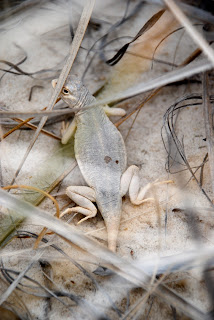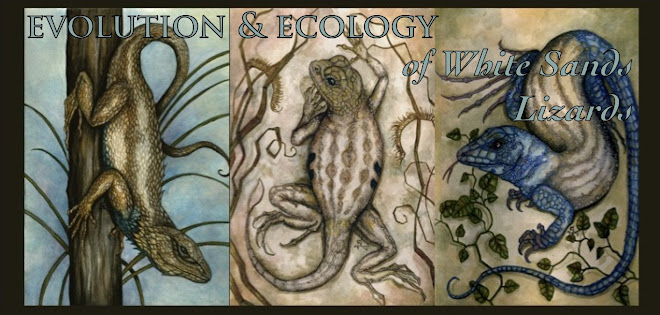 |
| Sunset at the ecotone |
Like a newly emerged volcanic island, or a pristine glacial lake, White Sands formed rapidly, recently and supports an ecosystem physically and biologically distinctive from the surrounding scrubland desert. Its reptilian inhabitants colonized in the last few thousand years and in parallel, evolved longer legs, broader heads, and white colouration. The three species are only distantly related to one another, yet their convergent body shape and colour at White Sands suggests that natural selection may be acting on all of them in a similar fashion.
The pale colour of White Sands lizards certainly makes them difficult to spot against the gypsum background. I have often come close to stepping on a little H. maculata, who only at the last moment appeared as a tiny ghost scuttling away from me over the sand. So colour loss may be an adaptation that allows camouflage from predators, and even prey. But the problem with ectotherms (cold-blooded animals) is that a change in colour means a change in how much time you must or must not spend in the sun. A little white lizard absorbs heat a lot slower than a darker lizard and that means it is exposed to predators longer, but may also be able to forage for longer.
Longer legs and toes enable many species of lizards to run faster on broad surfaces. Indeed, last year, I tested the hypothesis that White Sands lizards could run faster than their darker counterparts, especially on gypsum sand (stay tuned for the results!). Longer legs, however, maneuvering on smaller surfaces is more difficult. Perhaps the sparse vegetation in White Sands means that lizards must sprint long distances between cover. Lizards with longer legs may be at an advantage if they can run quickly across vast spaces.
The head and jaw of lizards will often affect how and what they eat. Typically, a larger head and jaw enable a more forceful bite; however, with the trade-off that the action of biting is slower. Thus, broad-headed lizards can often take large, tough prey – and perhaps that is what is available in White Sands. Head shape and size may also play a part in antagonistic behaviour with members of the same or different species.
 |
| Female H. maculata |
Whether the original cause of selection on White Sands lizards was related to thermoregulation, evading predation, social interaction, or diet, we do not yet know. The form and strength of selection on White Sands lizards in the past may be the same or different to selection now. The aim of my experiment this year is to quantify current selection on H. maculata living on the ecotone between White Sands and the dark-soiled scrubland desert. My field assistants and I will be capturing individuals, measuring the traits I listed above (dorsal skin colour and body size and shape) and recording their survivorship over several seasons. From these data I hope to determine if individuals with certain traits are more likely to survive.
I make three main predictions for any given trait:
- There is no selection acting and I observe no relationship between individual survivorship and their trait values.
- Directional selection is acting and I record higher survivorship in individuals with more extreme trait values in one direction, e.g. the lizards with the lightest colour survive, and those that are darker are selected against.
- Stabilizing selection is acting and I document highest survivorship in individuals with intermediate trait values, e.g. the lizards with intermediate leg length survive, and those with very long or very short legs are selected against.
Well that’s all the background information out of the way. I’m mighty behind on posting since we haven’t had the Internet for a while. We arrived in Alamogordo well over a week ago and have already begun catching, marking and releasing lizards. Our count is 22, with one unfortunate death. Please check back soon – I will introduce my stellar field assistants and let you know how we’re progressing!

No comments:
Post a Comment